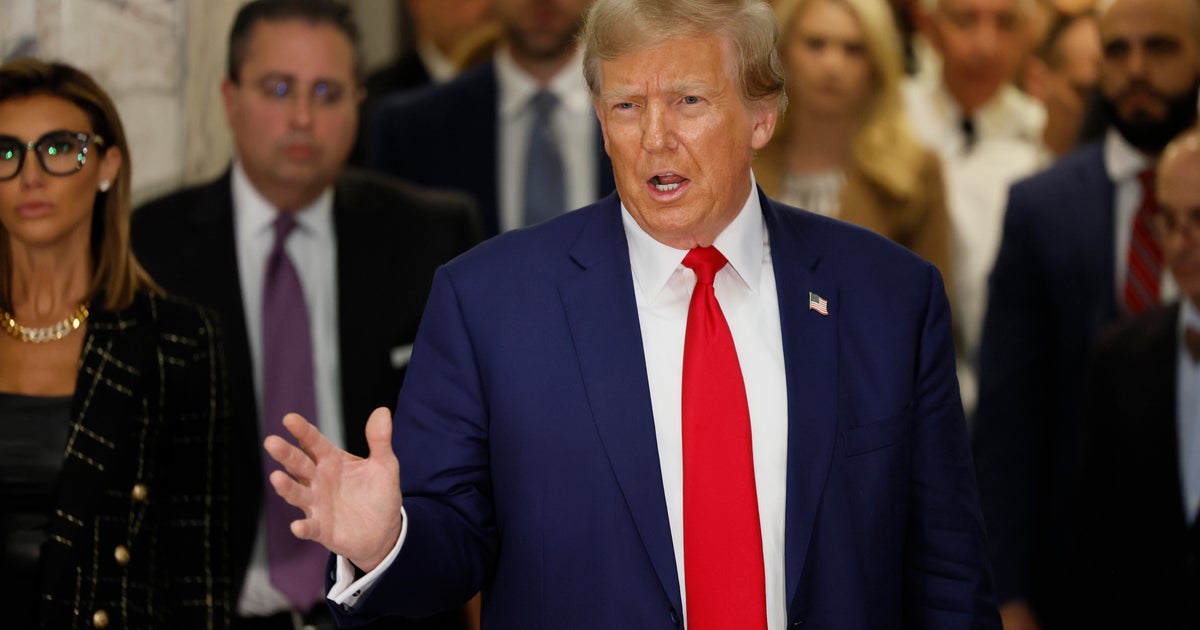Supreme Court grapples with whether to uphold ban on bump stocks for firearms
Washington — The Supreme Court on Wednesday wrestled with whether to uphold a Trump-era ban on bump stocks for firearms put in place in the wake of the 2017 mass shooting at a music festival in Las Vegas.
At issue in the case is whether a bump stock is a "machine gun" under federal law. The dispute does not involve the Second Amendment. Instead, it raises a question of statutory interpretation, specifically whether the Bureau of Alcohol, Tobacco, Firearms and Explosives had the authority to outlaw bump stocks.
A bump stock is an attachment that replaces a semi-automatic rifle's standard stock, the rear portion of the gun that rests on the shooter's shoulder. It allows the rest of the gun to move back and forth while the stock stays in place, and includes a finger rest that keeps the trigger finger still. When the gun is fired and the shooter applies forward pressure on the barrel, the rifle recoils back into the stock and bounces forward again, "bumping" the trigger into the finger and firing another round. The device allows the shooter to fire far more rapidly than is possible with a standard stock.
Oral arguments in the case, known as Garland v. Cargill, focused on whether an ATF regulation banning the device was allowable under a federal law that effectively outlawed machine guns. Some of the justices seemed inclined to agree that the law, originally enacted in 1934 to regulate the sale and possession of machine guns, could cover bump stocks. But at least two of the conservative justices raised concerns that ATF's shifting policies regarding the legality of the devices could leave unwitting owners subject to criminal penalties.
The 1934 law defines a machine gun as "any weapon which shoots, is designed to shoot, or can be readily restored to shoot, automatically more than one shot, without manual reloading, by a single function of the trigger." The definition also encompasses "any part designed and intended solely and exclusively, or combination of parts designed and intended, for use in converting a weapon into a machine gun."
ATF concluded in 2018 that a bump stock qualifies as a machine gun, as laid out in federal law, after a gunman wielding semi-automatic weapons equipped with bump stocks opened fire on a crowd of concert-goers attending a music festival in Las Vegas, killing 58 people and wounding roughly 500 more. The regulation, though, was swiftly challenged by a Texas man who owned two bump stocks and argued it was invalid.
Bump stocks at the Supreme Court
Much of the 90 minutes of arguments at the Supreme Court were highly technical, as the justices focused on the mechanics of a semi-automatic rifle equipped with a bump stock, and what a shooter does to fire a gun with the device.
Several of the justices dug into the phrase "single function of the trigger" and questioned why Congress would enact a law that prohibited machine guns, but allow for a device that enables a semi-automatic rifle to fire at a similar rate.
"Can you imagine a legislator thinking, we should ban machine guns, but we should not ban bump stocks? Is there any reason a legislator might reach that judgment?" Justice Samuel Alito asked Jonathan Mitchell, who was arguing for the ban to be invalidated.
Mitchell told the justices that a shooter with arthritis or dexterity issues may prefer to use a gun outfitted with a bump stock, though his suggestion was swiftly challenged by Justice Sonia Sotomayor.
"Why would a person with arthritis, why would Congress think they needed to shoot 400 to 700 or 800 rounds of ammunition under any circumstance?" she said. "If you don't let a person without arthritis do that, why would you permit a person with arthritis to do that?"
Justice Elena Kagan suggested that applying "a little common sense" when reading the law would indicate that Congress was concerned about a weapon that "fires a multitude of shots with a single human action," whether it's a conventional machine gun, where continuous pressure is applied to the trigger, or a firearm equipped with a bump stock, where continuous pressure is applied to the barrel.
"It functions in precisely the same way and a torrent of bullets comes out," she said. "And this is in the heartland of what they were concerned about, which is anything that takes just a little human action to produce more than one shot is what they were getting at."
The legal fight over bump stocks
Following the 2017 mass shooting at the Route 91 Harvest Music Festival, then-President Donald Trump directed the Justice Department to propose a new rule prohibiting all devices "that turn legal weapons into machine guns."
ATF had determined on several occasions between 2008 and 2017 that bump stocks do not qualify as machine guns and are not regulated under federal law. But it reversed course following the massacre, during which the gunman used semi-automatic weapons outfitted with bump stocks. The devices allowed him to fire up to 1,000 rounds of ammunition in 11 minutes, according to the FBI, killing 58 people in the rampage — two others died later — and injuring roughly 500 more.
In its new rule, issued in December 2018, ATF determined that a rifle equipped with a bump stock qualifies as a machine gun, in part because when a shooter pulls the trigger, it initiates a firing sequence that produces more than one shot. The sequence is "automatic," the agency found, "because the device harnesses the firearm's recoil energy as part of a continuous back-and-forth cycle that allows the shooter to attain continuous firing after a single pull of the trigger."
The final rule from the Trump administration took effect in March 2019, and those who already had bump stocks were required to destroy the devices or turn them into ATF. Violators who continued to possess bump stocks could face criminal penalties.
While the rulemaking process was underway, Michael Cargill, the man at the center of the case, bought two bump stocks in April 2018. He surrendered them to ATF after the ban was adopted, and then challenged the regulation in federal district court in Texas.
The district court sided with ATF, finding that the bureau properly classified rifles outfitted with bump stocks as machine guns. A three-judge panel of the U.S. Court of Appeals for the 5th Circuit upheld the lower court's decision, determining that "bump stocks qualify as machine guns under the best interpretation of the statute."
But the full slate of judges on the 5th Circuit struck down the regulation. In a 13-3 decision in January 2023, the appeals court found that Congress must act to prohibit bump stocks. In a portion of the lead opinion written by Judge Jennifer Elrod, an eight-judge plurality said that bump stocks are clearly not covered by the statutory definition of machine gun. Twelve judges sided with Cargill and concluded that the definition of machine gun was ambiguous enough to invoke a legal principle known as the rule of lenity, which requires courts to interpret unclear criminal laws in a way that's most favorable to the defendant.
Other federal appeals courts have also considered the legality of the bump stock regulation. The U.S. Court of Appeals for the 6th Circuit applied the rule of lenity and sided with bump stock owner Scott Hardin, writing that "because the relevant statutory scheme does not clearly and unambiguously prohibit bump stocks, we are bound to construe the statute in Hardin's favor."
But a unanimous three-judge panel on the U.S. Court of Appeals for the District of Columbia Circuit let the rule stand, finding that a bump stock is a machine gun under federal firearms law because "under the best interpretation of the statute," the device is "a self-regulating mechanism that allows a shooter to shoot more than one shot through a single pull of the trigger."
In April 2023, the Biden administration appealed the 5th Circuit's ruling to the Supreme Court, arguing that a semi-automatic rifle equipped with a bump stock satisfies the definition of a machine gun under federal law.
The Justice Department argued that ATF's interpretation of the definition of machine gun is the correct and best one.
The Supreme Court's arguments
Early in Wednesday's arguments, Justices Neil Gorsuch and Brett Kavanaugh both raised concerns that people who owned bump stocks before ATF issued its ban could be prosecuted and face criminal penalties, even if they didn't know the devices were illegal.
"That's going to ensnare a lot of people who are not aware of the legal prohibition," Kavanaugh told Brian Fletcher, principal deputy solicitor general who was defending the ATF ban.
Fletcher noted that the agency sought to provide ample notice about the ban and gave owners time to surrender their devices to ATF. Gorsuch, though, retorted, "because people will sit down and read the Federal Register. That's what they do in their evening for fun, gun owners across the country crack it open next to the fire."
Justice Amy Coney Barrett told Fletcher that "intuitively, I am entirely sympathetic to your arguments. It seems like yes, this is functioning like a machine gun would." But she questioned why Congress didn't pass legislation to make bump stocks covered by the 1934 law more clearly.
Fletcher warned the justices that accepting Cargill's argument would make it "trivially easy" to evade the ban on machine guns.
"We think Congress in 1934 wrote this statute not just for the kinds of devices that existed then, but for other kinds of devices that could be created in the future that would do the same thing," he said. "It enacted and strengthened these laws because it did not want members of the public or our nation's law enforcement officers to face the danger from weapons that let a shooter spray many bullets by making a single act. That's exactly what bump stocks do."
But Mitchell, representing Cargill, argued that bump stocks fall outside the definition of machine gun for two reasons. First, since the trigger resets and must be reactivated between every shot from a weapon with a bump stock, the device doesn't cause the gun to fire more than one shot "by a single function of the trigger." Secondly, bump stocks do not enable a rifle to fire automatically, because the shooter has to engage in ongoing manual actions after activating the trigger.
"Everything about the bump firing process is manual, and there is no automated device such as a spring or a motor, in any of Mr. Cargill's non-mechanical bump stocks," he said. "The process depends entirely on human effort and exertion, as the shooter must continually and repeatedly trust the forestock of the rifle forward with its non-shooting hand while simultaneously maintaining backward pressure on the weapon with his shooting hand. None of these acts are automated."
A decision from the Supreme Court is expected by the end of June.




